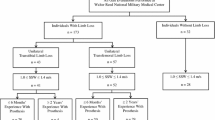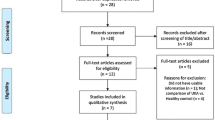Abstract
Background
Energy cost of ambulation has been evaluated using a variety of measures. With aberrant motions resulting from compensatory strategies, persons with transfemoral amputations generally exhibit a larger center of mass excursion and an increased energy cost. However, few studies have analyzed the effect of residual femur length and orientation or energy cost of ambulation.
Questions/purposes
The purpose of this study was to compare residual limb length and orientation with energy efficiency in patients with transfemoral amputation. We hypothesized that patients with shorter residual limbs and/or more abnormal residual femur alignment would have higher energy expenditure cost and greater center of mass movement than those with longer residual limbs resulting from lacking musculature, shorter and/or misoriented lever arms, and greater effort required to ambulate through use of compensatory movements.
Methods
Twenty-six adults with acute, trauma-related unilateral transfemoral amputations underwent gait and metabolic analysis testing. Patients were separated into groups for analysis based on residual limb length and residual femoral angle.
Results
Cohorts with longer residual limbs walked faster than those with shorter residual limbs (self-selected walking velocity 1.28 m/s versus 1.11 m/s, measured effect size = 1.08; 95% confidence interval = short 1.10–1.12, long 1.26–1.30; p = 0.04). However, there were no differences found with the numbers available between the compared cohorts regardless of limb length or orientation in regard to O2 cost or other metabolic variables, including the center of mass motion.
Conclusions
Those with longer residual limbs after transfemoral amputation chose a faster self-selected walking velocity, mirroring previous studies; however, metabolic energy and center of mass metrics did not demonstrate a difference in determining whether energy expenditure is affected by length or orientation of the residual limb after transfemoral amputation. These factors may therefore have less effect on transfemoral amputee gait efficiency and energy requirements than previously thought.
Level of Evidence
Level II, prognostic study. See the Guidelines for Authors for a complete description of levels of evidence.
Similar content being viewed by others
References
Aleshinsky SY. An energy ‘sources’ and ‘fractions’ approach to the mechanical energy expenditure problem–II. Movement of the multi-link chain model. J Biomech. 1986;19:295–300.
Baum BS, Schnall BL, Tis JE, Lipton JS. Correlation of residual limb length and gait parameters in amputees. Injury. 2008;39:728–733.
Bell JC, Wolf EJ, Schnall BL, Tis JE, Tis LL, Benjamin KPM. Transfemoral amputations: the effect of residual limb length and orientation on gait analysis outcome measures. J Bone Joint Surg Am. 2013;95:408–414.
Bellmann M, Schmalz T, Blumentritt S. Comparative biomechanical analysis of current microprocessor-controlled prosthetic knee joints. Arch Phys Med Rehabil. 2010;91:644–652.
Blanc CH, Borens O. Amputations of the lower limb–an overview on technical aspects. Acta Chir Belg. 2004;104:388–392.
British Standards Institution. BS 7313 P3:1993 Prosthetics and Orthotics Part 3: Method of Describing Lower Limb Amputation Stumps; ISO 8548-2. London, UK: BSI Group; 1993:1–24.
Buckley JG, Spence WD, Solomonidis SE. Energy cost of walking: comparison of ‘intelligent prosthesis’ with conventional mechanism. Arch Phys Med Rehabil. 1997;78:330–333.
Burdett RG, Skrinar GS, Simon SR. Comparison of mechanical work and metabolic energy consumption during normal gait. J Orthop Res. 1983;1:63–72.
Cavagna GA, Kaneko M. Mechanical work and efficiency in level walking and running. J Physiol. 1977;268:467–481.
Cavagna GA, Saibene FP, Margaria R. External work in walking. J Appl Physiol. 1963;18:1–9.
Czerniecki JM, Gitter A, Weaver K. Effect of alterations in prosthetic shank mass on the metabolic costs of ambulation in above-knee amputees. Am J Phys Med Rehabil. 1994;73:348–352.
Detrembleur C, Vanmarsenille JM, De Cuyper F, Dierick F. Relationship between energy cost, gait speed, vertical displacement of centre of body mass and efficiency of pendulum-like mechanism in unilateral amputee gait. Gait Posture. 2005;21:333–340.
Donelan JM, Kram R, Kuo AD. Simultaneous positive and negative external mechanical work in human walking. J Biomech. 2002;35:117–124.
Genin JJ, Bastien GJ, Franck B, Detrembleur C, Willems PA. Effect of speed on the energy cost of walking in unilateral traumatic lower limb amputees. Eur J Appl Physiol. 2008;103:655–663.
Gitter A, Czerniecki J, Meinders M. Effect of prosthetic mass on swing phase work during above-knee amputee ambulation. Am J Phys Med Rehabil. 1997;76:114–121.
Gitter A, Czerniecki J, Weaver K. A reassessment of center-of-mass dynamics as a determinate of the metabolic inefficiency of above-knee amputee ambulation. Am J Phys Med Rehabil. 1995;74:332–338.
Goktepe AS, Cakir B, Yilmaz B, Yazicioglu K. Energy expenditure of walking with prostheses: comparison of three amputation levels. Prosthet Orthot Int. 2010;34:31–36.
Gordon KE, Ferris DP, Kuo AD. Metabolic and mechanical energy costs of reducing vertical center of mass movement during gait. Arch Phys Med Rehabil. 2009;90:136–144.
Gottschalk F. Transfemoral amputation. Biomechanics and surgery. Clin Orthop Relat Res. 1999;361:15–22.
Gottschalk F. Transfemoral amputation: surgical management. In: Smith DG, Michael JW, Bowker JH, American Academy of Orthopaedic Surgeons, eds. Atlas of Amputations and Limb Deficiencies: Surgical, Prosthetic, and Rehabilitation Principles. 3rd ed. Rosemont, IL, USA: American Academy of Orthopaedic Surgeons; 2004:533–540.
Gottschalk FA, Stills M. The biomechanics of trans-femoral amputation. Prosthet Orthot Int. 1994;18:12–17.
Goujon-Pillet H, Sapin E, Fode P, Lavaste F. Three-dimensional motions of trunk and pelvis during transfemoral amputee gait. Arch Phys Med Rehabil. 2008;89:87–94.
Hagberg K, Tranberg R, Zugner R, Danielsson A. Reproducibility of the physiological cost index among individuals with a lower-limb amputation and healthy adults. Physiother Res Int. 2011;16:92–100.
Hekmatfard M, Farahmand F, Ebrahimi I. Effects of prosthetic mass distribution on the spatiotemporal characteristics and knee kinematics of transfemoral amputee locomotion. Gait Posture. 2013;37:78–81.
Huston C, Dillingham T, Esquenazi A. Rehabilitation of the lower extremity amputee. In: Textbook of Military Medicine, ed. Part IV. Surgical Combat Casualty Care: Rehabilitation of the Injured Combatant. Vol 1. Washington, DC, USA: Office of the Surgeon General at TMM Publications; 1998:79–159.
Jaegers SM, Arendzen JH, de Jongh HJ. Changes in hip muscles after above-knee amputation. Clin Orthop Relat Res. 1995;319:276–284.
Jaegers SM, Arendzen JH, de Jongh HJ. Prosthetic gait of unilateral transfemoral amputees: a kinematic study. Arch Phys Med Rehabil. 1995;76:736–743.
Jaegers SM, Arendzen JH, de Jongh HJ. An electromyographic study of the hip muscles of transfemoral amputees in walking. Clin Orthop Relat Res. 1996;328:119–128.
Kaufman KR, Levine JA, Brey RH, McCrady SK, Padgett DJ, Joyner MJ. Energy expenditure and activity of transfemoral amputees using mechanical and microprocessor-controlled prosthetic knees. Arch Phys Med Rehabil. 2008;89:1380–1385.
Lehmann JF, Price R, Okumura R, Questad K, de Lateur BJ, Negretot A. Mass and mass distribution of below-knee prostheses: effect on gait efficacy and self-selected walking speed. Arch Phys Med Rehabil. 1998;79:162–168.
Maaref K, Martinet N, Grumillier C, Ghannouchi S, Andre JM, Paysant J. Kinematics in the terminal swing phase of unilateral transfemoral amputees: microprocessor-controlled versus swing-phase control prosthetic knees. Arch Phys Med Rehabil. 2010;91:919–925.
Massaad F, Lejeune TM, Detrembleur C. The up and down bobbing of human walking: a compromise between muscle work and efficiency. J Physiol. 2007;582:789–799.
Mullick S. Lower limb amputation: striking the balance. Ann R Coll Surg Engl. 1994;76:420–421.
Nowroozi F, Salvanelli ML, Gerber LH. Energy expenditure in hip disarticulation and hemipelvectomy amputees. Arch Phys Med Rehabil. 1983;64:300–303.
Pickard-Gabriel CJ, Ledford CL, Gajewski DA, Granville RR, Andersen RC. Traumatic transfemoral amputation with concomitant ipsilateral proximal femoral fracture. A report of two cases. J Bone Joint Surg Am. 2007;89:2764–2768.
Pinzur MS, Bowker JH. Knee disarticulation. Clin Orthop Relat Res. 1999;361:23–28.
Pinzur MS, Gold J, Schwartz D, Gross N. Energy demands for walking in dysvascular amputees as related to the level of amputation. Orthopedics. 1992;15:1033–1036; discussion 1036-1037.
Portney LG, Watkins MP. Foundations of Clinical Research: Applications to Practice. 2nd ed. Upper Saddle River, NJ, USA: Prentice Hall; 2000.
Saunders JB, Inman VT, Eberhart HD. The major determinants in normal and pathological gait. J Bone Joint Surg Am. 1953;35:543–558.
Schmalz T, Blumentritt S, Jarasch R. Energy expenditure and biomechanical characteristics of lower limb amputee gait: the influence of prosthetic alignment and different prosthetic components. Gait Posture. 2002;16:255–263.
Seymour R, Engbretson B, Kott K, Ordway N, Brooks G, Crannell J, Hickernell E, Wheeler K. Comparison between the C-leg microprocessor-controlled prosthetic knee and non-microprocessor control prosthetic knees: a preliminary study of energy expenditure, obstacle course performance, and quality of life survey. Prosthet Orthot Int. 2007;31:51–61.
Shawen SB, Doukas WC, Shrout JA, Ficke JR, Potter BK, Hayda RA, Keeling JJ, Granville RR, Smith DG. General surgical principles for the combat casualty with limb loss. Care of the Combat Amputee. Washington, DC, USA: Office of the Surgeon General at TMM Publications Borden Institute; 2009:117–152.
Sjodahl C, Jarnlo GB, Soderberg B, Persson BM. Pelvic motion in trans-femoral amputees in the frontal and transverse plane before and after special gait re-education. Prosthet Orthot Int. 2003;27:227–237.
Traballesi M, Porcacchia P, Averna T, Brunelli S. Energy cost of walking measurements in subjects with lower limb amputations: a comparison study between floor and treadmill test. Gait Posture. 2008;27:70–75.
Waters RL, Lunsford BR, Perry J, Byrd R. Energy-speed relationship of walking: standard tables. J Orthop Res. 1988;6:215–222.
Waters RL, Mulroy S. The energy expenditure of normal and pathologic gait. Gait Posture. 1999;9:207–231.
Waters RL, Perry J, Antonelli D, Hislop H. Energy cost of walking of amputees: the influence of level of amputation. J Bone Joint Surg Am. 1976;58:42–46.
Willems PA, Cavagna GA, Heglund NC. External, internal and total work in human locomotion. J Exp Biol. 1995;198:379–393.
Winter DA. A new definition of mechanical work done in human movement. J Appl Physiol. 1979;46:79–83.
Winter DA, Robertson DG. Joint torque and energy patterns in normal gait. Biol Cybern. 1978;29:137–142.
Zajac FE, Neptune RR, Kautz SA. Biomechanics and muscle coordination of human walking. Part I: introduction to concepts, power transfer, dynamics and simulations. Gait Posture. 2002;16:215–232.
Author information
Authors and Affiliations
Corresponding author
Additional information
The institution of one or more of the authors (EJW, BKP) has received, during the study period, grant funding from the USAMRMC Military Amputee Research Program.
All ICMJE Conflict of Interest Forms for authors and Clinical Orthopaedics and Related Research ® editors and board members are on file with the publication and can be viewed on request.
Clinical Orthopaedics and Related Research ® neither advocates nor endorses the use of any treatment, drug, or device. Readers are encouraged to always seek additional information, including FDA-approval status, of any drug or device prior to clinical use.
Each author certifies that his or her institution approved the human protocol for this investigation, that all investigations were conducted in conformity with ethical principles of research, and that informed consent for participation in the study was obtained.
About this article
Cite this article
Bell, J.C., Wolf, E.J., Schnall, B.L. et al. Transfemoral Amputations: Is There an Effect of Residual Limb Length and Orientation on Energy Expenditure?. Clin Orthop Relat Res 472, 3055–3061 (2014). https://doi.org/10.1007/s11999-014-3630-x
Published:
Issue Date:
DOI: https://doi.org/10.1007/s11999-014-3630-x




